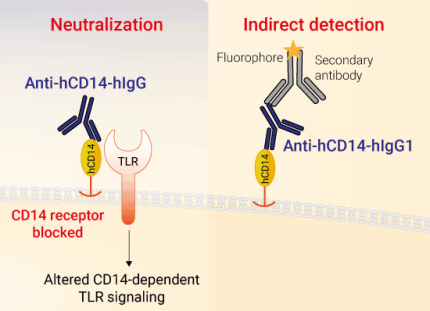
Anti-hCD14-IgG
-
Cat.code:
mabg-hcd14-2
- Documents
ABOUT
Neutralizing and detection IgG monoclonal antibody to human CD14
Anti-hCD14-hIgG1 (clone D3B8) is a chimeric monoclonal antibody specific for human CD14. This antibody was generated by recombinant DNA technology. It has been produced in Chinese hamster ovary (CHO) cells and purified by affinity chromatography. Anti-hCD14-hIgG1 has been selected for its ability to efficiently neutralize the biological activity of hCD14. It can also be used to detect hCD14 using flow cytometry.
CD14 is a glycosylphosphatidylinositol (GPI)-anchored membrane protein known to serve as a co-receptor for several TLRs [1]. Notably, CD14 serves as a member of the heteromeric lipopolysaccharide (LPS) receptor complex that also contains TLR4 and MD2 [2]. Furthermore, CD14 was shown to interact with TLR2 in response to various microbial infections [3].
Key features:
- Reacts with human CD14
- Provided azide-free
- Each lot is functionally tested
![]() Read our review on Toll-Like Receptors.
Read our review on Toll-Like Receptors.
References:
1. Pugin J. et al., 1994. CD14 is a pattern recognition receptor. Immunity. 1(6):509-16.
2. Da Silva Correia J. et al., 2001. Lipopolysaccharide is in close proximity to each of the proteins in its membrane receptor complex. transfer from CD14 to TLR4 and MD-2. J Biol Chem. 276(24): 21129-35.
3. Aderem A. & Ulevitch R.J., 2000. Toll-like receptors in the induction of the innate immune response. Nature. 406(6797):782-7.
All products are for internal research use only, and not for human or veterinary use.
SPECIFICATIONS
Specifications
CD14
Human
Neutralization assay (tested), Flow cytometry (tested)
Sodium phosphate buffer with glycine, saccharose, and stabilizing agents
Each lot is functionally tested and validated.
CONTENTS
Contents
-
Product:Anti-hCD14-IgG
-
Cat code:mabg-hcd14-2
-
Quantity:2 x 100 µg
Shipping & Storage
- Shipping method: Room temperature
- -20°C
- Avoid repeated freeze-thaw cycles
Storage:
Caution:
Details
CD14 is a glycosylphosphatidylinositol (GPI)-anchored membrane protein that acts as a bacterial pattern recognition receptor [1]. CD14 is found on cells derived from the monocyte/macrophage lineage, as well as neutrophils and B lymphocytes. CD14 serves as a member of the heteromeric lipopolysaccharide (LPS) receptor complex that also contains TLR4 and MD2 [2]. CD14 binds LPS but is not capable of initiating a transmembrane activation signal since it does not contain a cytoplasmic domain. Upon LPS binding, CD14 physically associates with TLR4 which in turn transduces the signal. CD14 was also shown to interact with TLR2 in response to various microbial infections [3].
1. Pugin J. et al., 1994. CD14 is a pattern recognition receptor. Immunity. 1(6):509-16.
2. Da Silva Correia J. et al., 2001. Lipopolysaccharide is in close proximity to each of the proteins in its membrane receptor complex. transfer from CD14 to TLR4 and MD-2. J Biol Chem. 276(24): 21129-35.
3. Aderem A. & Ulevitch R.J., 2000. Toll-like receptors in the induction of the innate immune response. Nature. 406(6797):782-7.
DOCUMENTS
Documents
Technical Data Sheet
Safety Data Sheet
Certificate of analysis
Need a CoA ?



